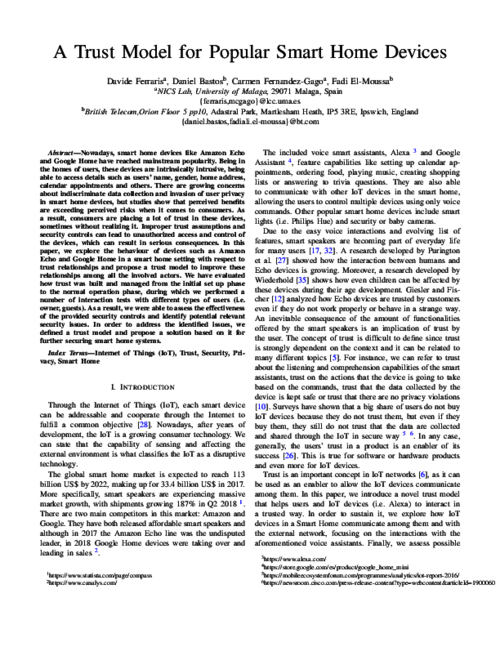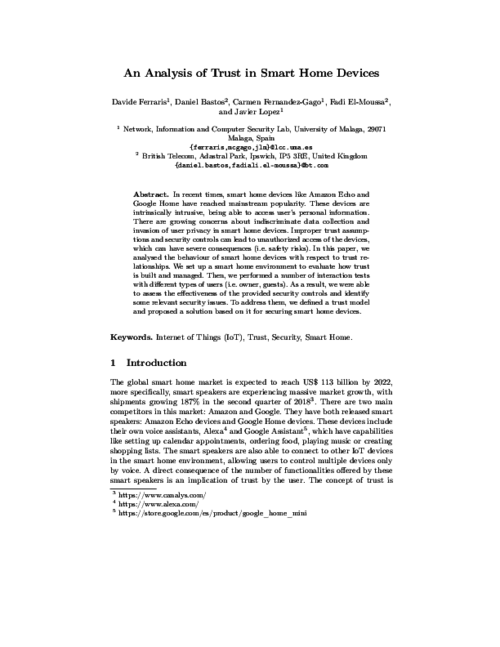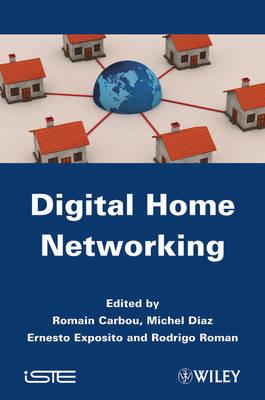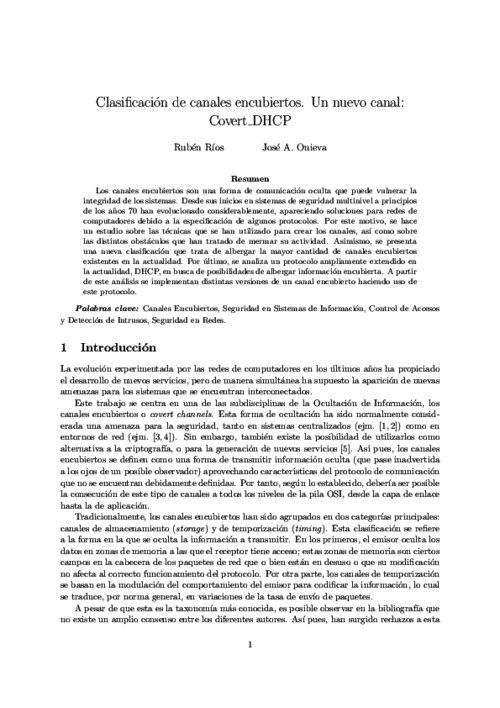 ]
] International Journal of Information Security, Springer, 2020. DOI
Abstract
Nowadays, smart home devices like Amazon Echo and Google Home have reached mainstream popularity.
Being in the homes of users, these devices are intrinsically intrusive, being able to access details such as users' name, gender, home address, calendar appointments and others.
There are growing concerns about indiscriminate data collection and invasion of user privacy in smart home devices, but studies show that perceived benefits are exceeding perceived risks when it comes to consumers.
As a result, consumers are placing a lot of trust in these devices, sometimes without realizing it.
Improper trust assumptions and security controls can lead to unauthorized access and control of the devices, which can result in serious consequences.
In this paper, we explore the behaviour of devices such as Amazon Echo and Google Home in a smart home setting with respect to trust relationships and propose a trust model to improve these relationships among all the involved actors.
We have evaluated how trust was built and managed from the initial set up phase to the normal operation phase, during which we performed a number of interaction tests with different types of users (i.e. owner, guests).
As a result, we were able to assess the effectiveness of the provided security controls and identify potential relevant security issues. In order to address the identified issues, we defined a trust model and propose a solution based on it for further securing smart home systems.

The 20th World Conference on Information Security Applications: WISA-Workshop 2019, Springer, 2019.
Abstract
In recent times, smart home devices like Amazon Echo and Google Home have reached mainstream popularity. These devices are intrinsically intrusive, being able to access user’s personal information. There are growing concerns about indiscriminate data collection and invasion of user privacy in smart home devices. Improper trust assumptions and security controls can lead to unauthorized access of the devices, which can have severe consequences (i.e. safety risks). In this paper, we analysed the behaviour of smart home devices with respect to trust relationships. We set up a smart home environment to evaluate how trust is built and managed. Then, we performed a number of interaction tests with different types of users (i.e. owner, guests). As a result, we were able to assess the effectiveness of the provided security controls and identify some relevant security issues. To address them, we defined a trust model and proposed a solution based on it for securing smart home devices.

Blockchain Protocol Analysis and Security Engineering 2018, 01/2018.
III Jornadas Nacionales de Investigación en Ciberseguridad, URJC, pp. 174-175, 06/2017.
Abstract
En este artículo presentamos un sistema que permite delegación de acceso a información cifrada para Apache Hadoop, de forma segura y transparente al usuario. Para ello usamos técnicas criptográficas avanzadas basadas en el recifrado delegado. Con este sistema, es posible almacenar en Hadoop los datos de forma cifrada y delegar de forma segura el acceso a los nodos de computación. El funcionamiento es transparente ya que se integra con la capa del sistema de ficheros nativa HDFS. Además, el recifrado delegado permite hacer rotación de claves de cifrado de forma segura y rápida.
Digital Home Networking
, Wiley-ISTE, 2011.
 |  |
Digital Home Networking, R. Carbou, E. Exposito, R. Roman, and M. Diaz Eds., no. 7130, John Wiley & Sons Inc., pp. 60-96, 2011.
Digital Home Networking, R. Carbou, E. Exposito, and R. Roman Eds., Wiley-ISTE, pp. 17 - 58, 2011.
Digital Home Networking, R. Carbou, M. Diaz, E. Exposito, and R. Roman Eds., pp. 139-202, 2011.
X Reunión Española de Criptología y Seguridad de la Información (RECSI’08), L. Hernández Encinas, and A. Martin del Rey Eds., pp. 325-336, Sept., 2008.
Abstract
Los canales encubiertos son una forma de comunicación oculta que puede vulnerar la integridad de los sistemas. Desde sus inicios en sistemas de seguridad multinivel a principios de los años 70 han evolucionado considerablemente, apareciendo soluciones para redes de computadores debido a la especificación de algunos protocolos. Por este motivo, se hace un estudio sobre las técnicas que se han utilizado para crear los canales, así como sobre las distintos obstáculos que han tratado de mermar su actividad. Asimismo, se presenta una nueva clasificación que trata de albergar la mayor cantidad de canales encubiertos existentes en la actualidad. Por último, se analiza un protocolo ampliamente extendido en la actualidad, DHCP, en busca de posibilidades de albergar información encubierta. A partir de este análisis se implementan distintas versiones de un canal encubierto haciendo uso de este protocolo.
